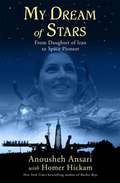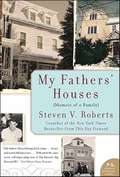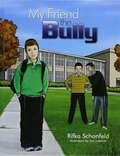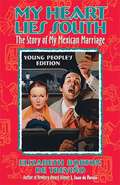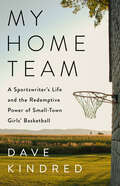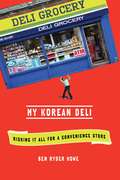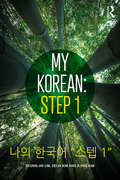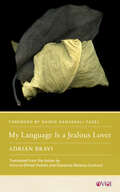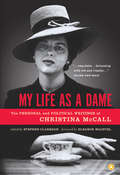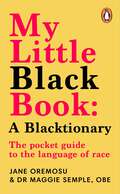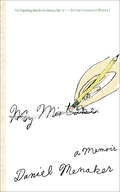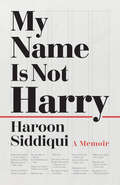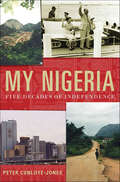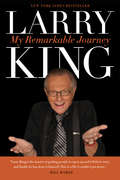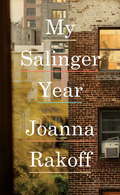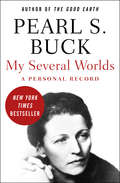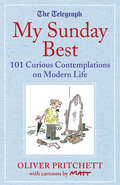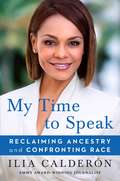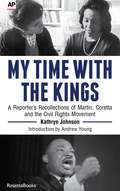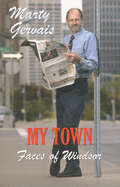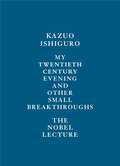- Table View
- List View
My Dream of Stars: From Daughter of Iran to Space Pioneer
by Homer Hickam Anousheh AnsariIn her heartwarming and empowering memoir, space pioneer Anousheh Ansari tells the story of her childhood in Iran and her family's exodus to America after the Islamic Revolution. After settling down in Texas, Anousheh built a computer technology firm from the ground up, which eventually realized a net worth of $750 million and ultimately allowed her to achieve her childhood dream of spaceflight. In her groundbreaking role as the first-ever female commercial spaceflight participant, her story became politicized and fraught with the prejudices and obstacles she had to overcome as an Iranian woman, culminating in a debate over whether she would be allowed to display both the American and Iranian flags on the sleeve of her spacesuit. After her return to Earth, Anousheh started The Ansari Foundation, a quickly growing nonprofit which supports social entrepreneurship, and is especially committed to ensuring the freedom of women around the world and supporting female entrepreneurs. Ultimately, this evocative story shows the triumph of a woman who has become a role model to people around the globe struggling to overcome economic and cultural barriers, as well as those dreamers who look upon the stars and wish to soar among them.
My Fathers' Houses: Memoir of a Family
by Steven V. RobertsFrom Steven V. Roberts comes My Fathers' Houses, a memoir of growing up in Bayonne, New Jersey, an immigrant community in the shadow of the Statue if Liberty, and the story of how his father and his grandfather's dreams–and their own passion for writing and ideas–influenced Steven's future, and inspired him to seek his fortune in New York City, the media capital of the world. This is a story of a town and a time and a boy who grew up there, a boy who became a New York Times correspondent, TV and radio personality, and best–selling author. The town was Bayonne, New Jersey, a European village so close to New York that Steve could see the Statue of Liberty from his bedroom window. The time was the forties and fifties, when children of immigrants were striving to become American and find a place in a booming post–war world. The core of Steve's world was one block, where he lived in a house his grandfather, Harry Schanbam, had built with his own hands. But the story starts back in Russia, where the family business of writing and ideas began. Steve's other grandfather, Abraham Rogowsky, stole money to become a Zionist pioneer in Palestine before moving to America. The tale continues through the Depression, when Steve's parents lived one block apart in Bayonne, wrote letters to each other and married in secret. During the war years, Steve's father wrote children's books and based one of his best sellers on outings he took with his twin sons to the local train station. As his byline, he used his boys' middle names–Jeffrey Victor–so Steve got his first writing credit before he was two. The story concludes with the boy leaving Bayonne, going on to Harvard, meeting the Catholic girl who became his wife, and starting work at the New York Times–across the river, and worlds away, from where he began. Now a grandfather of five, Steve Roberts looks in the mirror and sees his own father and grandfather looking back at him–a family chain that started in 19th century Russia and thrives today in 21st century America.
My Friend the Bully
by Rifka Schonfeld Yoel JudowitzBullying, teasing, and other forms of harassment is a painful reality children deal with both in and out of school, and those on the receiving end often suffer in silence. If left unaddressed, this can damage a child s self-esteem, hamper his ability to learn and grow, and generate feelings of fear, shame, depression, and anxiety. My Friend the Bully tackles this difficult topic in an effective, informative, positive way.
My Heart Lies South: The Story of My Mexican Marraige
by Elizabeth Borton de TrevinoWhat happens when a thoroughly twentieth-century American lady journalist becomes a Mexican señora in nineteen-thirties' provincial Monterrey? She finds herself-sometimes hilariously-coping with servants, daily food allowances, bargaining, and dramatic Latin emotions. In this vivid autobiography, Newbery Award winning author Elizabeth Borton de Treviño brings to life her experiences with the culture and the faith of a civilization so close to the United States, but rarely appreciated or understood. This special young people's edition presents the humor and the insights of a remarkable woman and her contact with an era which is now past, but not to be forgotten.
My Home Team: A Sportswriter's Life and the Redemptive Power of Small-Town Girls Basketball
by Dave KindredIn this poignant memoir, a legendary sports journalist writes about the team that changed his life: the Morton High School Lady Potters basketball team. Dave Kindred has covered dozens of Super Bowls and written about stars like Muhammad Ali, Tiger Woods, and Michael Jordan. But a high-school girls basketball team—the Lady Potters of Morton, Illinois—stands apart from the rest. In this moving and intimate story, Kindred writes about his rise to professional success and the changes that brought him back to his hometown late in life. As he dealt with personal hardship, his urge to write sustained him. For years, he has recapped the games of the Lady Potters, including their many runs to state championships. He attended game after game, sitting in the stands and making notes, paid nothing but Milk Duds. And the team and their community were there for him as he lost a grandson to addiction and his wife to long-term illness. Tender and honest, Kindred&’s story reminds readers what sports are really about. He trades in the exhausting spectacle of Super Bowl Sunday for the joy of togetherness, the fire of competition, and the inexhaustible hope for victory tomorrow.
My Ideal Bookshelf
by Jane Mount Thessaly La ForceThe books that we choose to keep --let alone read-- can say a lot about who we are and how we see ourselves. In MY IDEAL BOOKSHELF, dozens of leading cultural figures share the books that matter to them most; books that define their dreams and ambitions and in many cases helped them find their way in the world. Contributors include Malcolm Gladwell, Thomas Keller, Michael Chabon, Alice Waters, James Patterson, Maira Kalman, Judd Apatow, Chuck Klosterman, Miranda July, Alex Ross, Nancy Pearl, David Chang, Patti Smith, Jennifer Egan, and Dave Eggers, among many others. With colorful and endearingly hand-rendered images of book spines by Jane Mount, and first-person commentary from all the contributors, this is a perfect gift for avid readers, writers, and all who have known the influence of a great book.
My Korean Deli: Risking It All For a Convenience Store
by Ben Ryder HoweThis sweet and funny tale of a preppy editor buying a Brooklyn deli with his Korean in-laws is about family, culture clash, and the quest for authentic experiences.
My Korean: 나의 한국어 “스텝 1”
by Jieun Kim Ji-Hye Kim Byung-jin LimThe My Korean series of textbooks offers a learner-centred, communicative task-based, interactive approach to learning contemporary Korean. My Korean: Step 1 and My Korean: Step 2 are arranged thematically around topics that any novice learner of Korean is likely to encounter in their first year of study. Each lesson contains two dialogues showing contemporary Korean in use, followed by succinct grammar and vocabulary explanations. The focus throughout the books is on communicative in-class activities and tasks that encourage students’ active participation. Video clips of the lesson dialogues are available as an online resource, and each unit contains communicative activities based on the dialogue themes. The engaging structure and communicative approach make My Korean: Step 1 an ideal text for first semester Korean courses. It is also a great resource for individual study or one-on-one tutorials on Korean language and culture.
My Language Is a Jealous Lover (Other Voices of Italy)
by Adrián N. BraviMany great writers have been fluent in multiple languages but have never been able to escape their mother tongue. Yet if a native language feels like home, an adopted language sometimes offers a hospitality one cannot find elsewhere. My Language Is a Jealous Lover explores the plights and successes of authors who lived and wrote in languages other than their mother tongue, from Samuel Beckett and Vladimir Nabokov to Ágota Kristóf and Joseph Brodsky. Author Adrián N. Bravi weaves their stories in with his own experiences as an Argentinian-Italian, thinking and writing in the language of his new life while recalling that of his childhood. Bravi bears witness to the frustrations, the soul-searching, the pain, and the joys of embracing another language.
My Life and the Times
by Turner Catledge(From inside book flap) Catledge is a born storyteller, and his book is full of entertaining anecdotes. He tells of his days as a brash young reporter in the South and later on the Capitol Hill beat, where he tried to save face for a heavy-drinking Vice President-elect and fended off President Roosevelt's attempt to get him to betray his boss, Arthur Krock. In due course he passed the test for high position on the Times--he survived a drinking bout with publisher Arthur Hauys Sulzberger. Then began his long, eventful service as a major news exective in New York.
My Life as Author and Editor
by H. L. Mencken Jonathan YardleyH. L. Mencken stipulated in his will that the manuscript not be read for thirty-five years so that no one mentioned in its pages would still be alive on publication, thus giving the author the freedom to write what he pleased. The narrative contains many profiles and reminiscences covering Mencken's years in the magazine world, particularly with the "Smart Set", which he co-edited with George Jean Nathan. The heart of the book, however, lies in the descriptions of the relationships - rivalries, feuds, friendships and mentorships - that Mencken carried on with many of the significant writers of the twentieth century, including Theodore Dreiser, James Joyce, Willa Cather, Ezra Pound, Eugene O'Neill, Frank Harris, F. Scott Fitzgerald, Aldous Huxley and Sinclair Lewis. Full of wonderfully revealing anecdotes and biting observations, these pages are spiked with his trademark outrageous and pugnacious wit, as well as his alarming frankness. Although the memoir breaks off in the early 1920's because of a stroke he suffered in 1948, it contributes significantly to our understanding of the legendary literary era of which he was at the center. It also makes abundantly clear -- if proof were ever needed -- why he was our greatest social commentator, and why he has had an enduring impact on American society and letters.
My Life as a Dame: The Personal and Political Writings of Christina McCall
by Christina McCallIn February 1956, a remarkable young woman named Christina McCall began her working life as an editorial secretary at Maclean's magazine. It was a legendary time there, when the likes of Pierre Berton, Robert Fulford, June Callwood, Peter Gzowski, and Peter C. Newman graced the magazine's pages. McCall would come to join that illustrious group, and be considered not only one of the best political writers of her generation, but a pioneer for women in journalism and one of Canada's most brilliant minds. For the first time, the best of McCall's articles and essays have been collected in one definitive volume alongside excerpts from her unfinished memoirs. Covering topics from the Alberta oil boom to the rise of divorce rates in Canada to in-depth profiles of the Ottawa establishment, McCall's clear-eyed observations are not only laced with insight, humour, and compassion, they continue to be relevant today.
My Little Black Book: The pocket guide to the language of race
by Maggie Semple Jane OremosuThrough their work with organisations and companies across the world, Maggie Semple and Jane Oremosu found that there was a need to help people as they discussed difference, race and inclusion. My Little Black Book: A Blacktionary aims to do just that.This A-Z pocket guide is for people who are entering the workplace and finding their identity, for leaders and managers who feel overwhelmed by ever-evolving definitions and phrases, for anyone who is afraid of saying the wrong thing and being judged. From explaining what microagressions are and their impact, to helping you understand what cultural appreciation is and how it's different to cultural appropriation, this book will break down barriers to engaging in conversations on race.Drawing together the best definitions as well as useful advice and tips, My Little Black Book: A Blacktionary is an essential tool to broaden your knowledge and live and work better with others.
My Mistake: A Memoir
by Daniel MenakerA former New Yorker editor and book publisher shares a &“ruefully funny insider&’s tour of the publishing world&” in this delightful memoir (Vogue.com). A New York Times Book Review Editors&’ Choice Daniel Menaker started as a fact checker at The New Yorker in 1969. With luck, hard work, and the support of William Maxwell, he was eventually promoted to editor. Never beloved by the magazine&’s legendary editor William Shawn, he was advised early on to find a position elsewhere; he stayed for another twenty-four years. Now Menaker offers an insightful and intimate account of that wonderfully strange place—as well as the publishing world at large and his own life—in this &“tender, smart, and witty&” memoir (Real Simple).My Mistake is a moving, thoughtful meditation on years well lived, well read, and well spent. Full of mistakes, perhaps. But full of effort, full of accomplishment, full of life.&“Energetic and exhilarating . . . [Menaker&’s] clever, fast-paced prose makes you stop and think and wonder.&” —New York Times Book Review
My Name Is Not Harry: A Memoir
by Haroon Siddiqui“A distinctive and insightful perspective on being Muslim in the post-9/11 world.” — Charles TaylorVeteran Toronto Star editor Haroon Siddiqui, brown and Muslim, has spent a life on the media front lines, covering conflicts both global and local, and tracked rising xenophobia.Canada has no official culture. It follows that there's no standard way of being Canadian, beyond obeying the law. Toronto Star editor Haroon Siddiqui shows how Canada let him succeed on his own terms.Coming from India in 1967, he didn't do in Rome as some Romans expected him to. He refused to forget his past. He didn't change his name, didn't dilute his dignity, didn't compromise his conscience or his dissident views. Championed immigration and multiculturalism when that was not popular. Upbraided media colleagues for being white-centric, Orientalist. Pioneered cross-cultural journalism, bridging divided communities. Insisted it was un-Canadian to use free speech as a licence for hate speech. Opposed the limitless American war on terror, the invasion of Iraq, the long war on Afghanistan. Exposed how liberals could also be narrow-minded and nasty.Here he shares such journalistic forays into the corridors of power, war zones, and cultural minefields. He also takes the reader along his personal journey from British colonial India to the evolution of Canada as the only Western nation where skin colour is no longer a fault line.
My Nigeria: Five Decades of Independence
by Peter Cunliffe-JonesHis nineteenth-century cousin, paddled ashore by slaves, twisted the arms of tribal chiefs to sign away their territorial rights in the oil-rich Niger Delta. Sixty years later, his grandfather helped craft Nigeria's constitution and negotiate its independence, the first of its kind in Africa. Four decades later, Peter Cunliffe-Jones arrived as a journalist in the capital, Lagos, just as military rule ended, to face the country his family had a hand in shaping.Part family memoir, part history, My Nigeria is a piercing look at the colonial legacy of an emerging power in Africa. Marshalling his deep knowledge of the nation's economic, political, and historic forces, Cunliffe-Jones surveys its colonial past and explains why British rule led to collapse at independence. He also takes an unflinching look at the complicated country today, from email hoaxes and political corruption to the vast natural resources that make it one of the most powerful African nations; from life in Lagos's virtually unknown and exclusive neighborhoods to the violent conflicts between the numerous tribes that make up this populous African nation. As Nigeria celebrates five decades of independence, this is a timely and personal look at a captivating country that has yet to achieve its great potential.
My Odyssey: An Autobiography
by Nnamdi AzikiweMan comes into the world, and while he lives he embarks upon a series of activities, absorbing experience which enables him to formulate a philosophy of life, and to chart his courses of action; but then he dies. Nevertheless, his biography remains as a guide to those of the living who may need guidance, either as a warning on the vanity of human wishes, or as an encouragement, or both.
My Remarkable Journey (Playaway Adult Nonfiction Ser.)
by Larry KingThe definitive autobiography of one of the most legendary and beloved personalities in television history
My Salinger Year
by Joanna RakoffPoignant, keenly observed, and irresistibly funny: a memoir about literary New York in the late nineties, a pre-digital world on the cusp of vanishing, where a young woman finds herself entangled with one of the last great figures of the century. At twenty-three, after leaving graduate school to pursue her dreams of becoming a poet, Joanna Rakoff moves to New York City and takes a job as assistant to the storied literary agent for J. D. Salinger. She spends her days in a plush, wood-paneled office, where Dictaphones and typewriters still reign and old-time agents doze at their desks after martini lunches. At night she goes home to the tiny, threadbare Williamsburg apartment she shares with her socialist boyfriend. Precariously balanced between glamour and poverty, surrounded by titanic personalities, and struggling to trust her own artistic instinct, Rakoff is tasked with answering Salinger's voluminous fan mail. But as she reads the candid, heart-wrenching letters from his readers around the world, she finds herself unable to type out the agency's decades-old form response. Instead, drawn inexorably into the emotional world of Salinger's devotees, she abandons the template and begins writing back. Over the course of the year, she finds her own voice by acting as Salinger's, on her own dangerous and liberating terms. Rakoff paints a vibrant portrait of a bright, hungry young woman navigating a heady and longed-for world, trying to square romantic aspirations with burgeoning self-awareness, the idea of a life with life itself. Charming and deeply moving, filled with electrifying glimpses of an American literary icon, My Salinger Year is the coming-of-age story of a talented writer. Above all, it is a testament to the universal power of books to shape our lives and awaken our true selves. From the Hardcover edition.
My Several Worlds: A Personal Record
by Pearl S. BuckThe extraordinary and eventful personal account of the life of Pearl S. Buck, the first American woman to win the Nobel Prize for LiteratureOften regarded as one of Pearl S. Buck's most significant works, My Several Worlds is the memoir of a major novelist and one of the key American chroniclers of China. Buck, who was born to missionary parents in 1892, spent much of the first portion of her life in China, experiencing the Boxer Rebellion first hand and becoming involved with the society with an intimacy available to few outside observers. The book is not only an important reflection on that nation's modern history, but also an account of her re-engagement with America and the intense activity that characterized her life there, from her prolific novel-writing to her loves and friendships to her work for abandoned children and other humanitarian causes. As alive with incident as it is illuminating in its philosophy, My Several Worlds is essential reading for travelers and readers alike. This ebook features an illustrated biography of Pearl S. Buck including rare images from the author's estate.
My Sunday Best: 101 Curious Contemplations on Modern Life
by Oliver PritchettA witty compendium of musings on modern life from two of Britain’s best-loved father and son humorists.Ever unafraid to tackle the great matters of the day—and even more at home in the company of the apparently trivial—Oliver Pritchett might lament the lost art of how to end a tedious phone conversation, report on his investigations into the world’s “superfruits,” or answer such a pressing question as, How does one spot a Bank Holiday? Why do we clap at things that don’t need applause? or, What is the correct protocol should Prince William land a helicopter in one’s garden?Anthologized for the first time, and illustrated by his son Matt’s brilliantly witty cartoons, Oliver’s writings reflect upon just how quaint, odd and beautifully absurd life is.So we invite you to sit back and enjoy this whimsical and comical collection of curious contemplations, which quite simply, well, “Just occured to me . . .”
My Time to Speak: Reclaiming Ancestry and Confronting Race
by Ilia CalderónAn inspiring, timely, and conversation-starting memoir from the barrier-breaking and Emmy Award–winning journalist Ilia Calderón—the first Afro-Latina to anchor a high-profile newscast for a major Hispanic broadcast network in the United States—about following your dreams, overcoming prejudice, and embracing your identity.As a child, Ilia Calderón felt like a typical girl from Colombia. In Chocó, the Afro-Latino province where she grew up, your skin could be any shade and you&’d still be considered blood. Race was a non-issue, and Ilia didn&’t think much about it—until she left her community to attend high school and college in Medellín. For the first time, she became familiar with horrifying racial slurs thrown at her both inside and outside of the classroom. From that point on, she resolved to become &“deaf&” to racism, determined to overcome it in every way she could, even when she was told time and time again that prominent castings weren&’t &“for people like you.&” When a twist of fate presented her the opportunity of a lifetime at Telemundo in Miami, she was excited to start a new life, and identity, in the United States, where racial boundaries, she believed, had long since dissolved and equality was the rule. Instead, in her new life as an American, she faced a new type of racial discrimination, as an immigrant women of color speaking to the increasingly marginalized Latinx community in Spanish. Now, Ilia draws back the curtain on the ups and downs of her remarkable life and career. From personal inner struggles to professional issues—such as being directly threatened by a Ku Klux Klan member after an interview—she discusses how she built a new identity in the United States in the midst of racially charged violence and political polarization. Along the way, she&’ll show how she&’s overcome fear and confronted hate head on, and the inspirational philosophy that has always propelled her forward.
My Time with the Kings: A Reporter’s Recollections of Martin, Coretta and the Civil Rights Movement
by Andrew Young Kathryn Johnson“Let Kathryn in,” said Coretta Scott King to authorities.Three simple words that provided Kathryn Johnson, a reporter for The Associated Press’s Atlanta bureau, unprecedented access to the grieving widow in the days following her husband’s death.Johnson was on her way to a movie date when word came from Memphis that Martin Luther King Jr. had been assassinated. She immediately headed for the King home where, despite resistance from authorities on the scene, she was the only reporter allowed inside. Johnson’s many years covering King and his family had earned her the trust to be a discreet, observant witness to the aftermath of a defining moment in American history.Kathryn Johnson covered the civil rights movement across the South in the 1960s, often risking her own safety to observe first-hand the events of this great era. Her stories took her from witnessing the integration of the University of Georgia by dressing as a student, to hiding unobserved under a table near an infamous schoolhouse door in Alabama, to marching with the massive crowd from Selma to Montgomery.Johnson, one of the only female reporters on the scene, threw herself into charged situations with a determination to break the news no matter what. Including never-before-published photos, her personal account of this period is a singular addition to the story of the civil rights movement.
My Town
by Marty GervaisMy Town brings together more than 70 snapshots of the people and places that have called Windsor home. More than this, they have made Windsor, for better and for worse, the city it is today. Some of these faces you will recognize; others will have slipped beneath the radar. Marty has sought them out and made their stories his own.
My Twentieth Century Evening and Other Small Breakthroughs: The Nobel Lecture
by Kazuo IshiguroThe Nobel Lecture in Literature, delivered by Kazuo Ishiguro (The Remains of the Day, Never Let Me Go and When We Were Young) at the Swedish Academy in Stockholm, Sweden, on December 7, 2017, in an elegant, clothbound edition. <P><P>In their announcement of the 2017 Nobel Prize in Literature, the Swedish Academy recognized the emotional force of Kazuo Ishiguro’s fiction and his mastery at uncovering our illusory sense of connection with the world. In the eloquent and candid lecture he delivered upon accepting the award, Ishiguro reflects on the way he was shaped by his upbringing, and on the turning points in his career—“small scruffy moments . . . quiet, private sparks of revelation”—that made him the writer he is today. <P><P>With the same generous humanity that has graced his novels, Ishiguro here looks beyond himself, to the world that new generations of writers are taking on, and what it will mean—what it will demand of us—to make certain that literature remains not just alive, but essential. An enduring work on writing and becoming a writer, by one of the most accomplished novelists of our generation.
